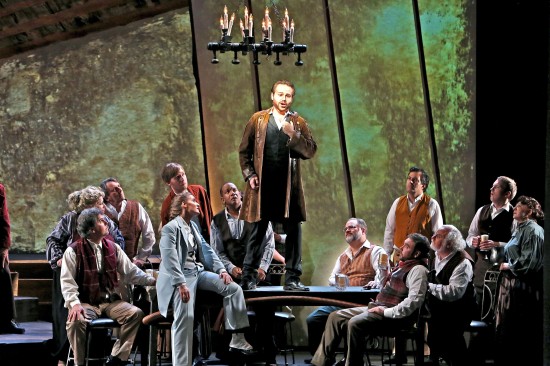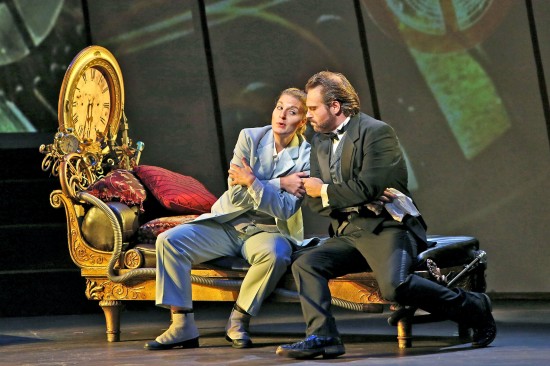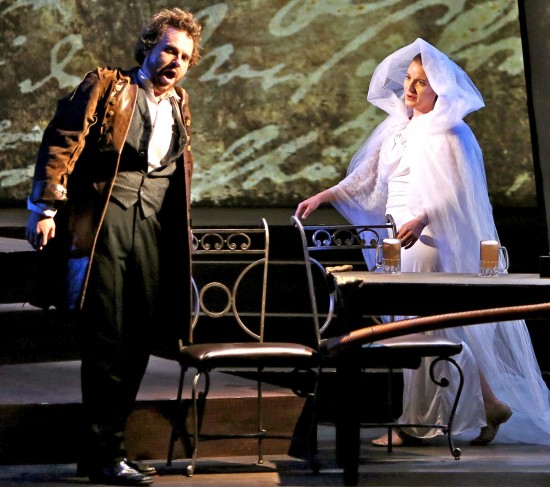I never get tired of seeing Offenbach’s Tales of Hoffmann. And a good thing, too, since in the space of three months I will have seen 6 performances of three quite different productions of the opera:
- A MetHD Encore of their 2009 production in July
- Two performances of a production by Pocket Opera in July/August
- Three performances of the current production by West Bay Opera.

Prologue; L-to-R in center: Betany Coffland as Nicklausse (in light suit), Mathew Pierce as Hermann (taller, blond, in red outfit), Darron Flagg as Nathana�l (in black vest) and Christopher Bengochea as Hoffmann (standing on the table)
The plot of the opera is simple – on the surface. Hoffmann is a poet who can write sublime poetry but is most unsuccessful in his love affairs. His current passion is Stella, the reigning opera diva of the day. Stella, however, figures only in the Epilogue and Prologue. The three acts of the opera are the stories of Olympia (a mechanical doll), Antonia (a concert singer), and Giulietta (a courtesan) – all as told by Hoffmann, reminiscing about his past. This situation poses a natural question: Did these events actually happen? Or are they products of a drunken poet’s distorted remembrances of past events?
There is no ambiguity as to which way Director Ragnar Conde sees it: Hoffmann and Stella are in a long term stormy relationship, and the other three women are inventions of the poet’s imagination that symbolize real events too painful to remember. Let me quote at length from the Director’s Note he wrote for the opera program:
Over the course of three fantastic stories, we see the transfigured relationship between these two artists [Stella and Hoffmann] who have obviously known each other since their youth. We see how each of them struggles to follow the artistic passion that consumes them, and how that passion ends up separating them.
The story of Olympia shows us not just a young and virtuous Stella, but also a young Hoffmann about to sacrifice his talent in order to lead a somewhat normal life. In the Antonia story, the poet has decided to follow his path, and this has separated him from his beloved. She, in turn, ends up giving in to her own impulse to sing, which automatically banishes her to the world of artists and courtesans, a form of societal death at that time. By the time the Giulietta story comes along, both artists have lost their way. Their passions have gotten the better of them and they are now doomed souls, immersed in a world that has perverted itself, and ready to sacrifice their own values in order to continue climbing.
Stella and Hoffmann cannot continue together along a common path. They have both taken a dive to the very bottom of the Dionysian barrel, a place brimming with excess. Their respective muses will not allow them to resurface other than to occasionally replenish their inspiration and continue creating.
In the fascinating talk-back session after the Sunday performance, Conde summarized his interpretation by referring to three different types of love: innocent love (Olympia), romantic love (Antonia) and “er – earthy love” (Giulietta).
There are two significant aspects that define distinctly different productions: the order in which the Antonia and Giulietta episodes are presented, and the number of different sopranos appearing in the production. Given the director’s vision, I can’t argue with his choice of order: Olympia, Antonia, and Giulietta. Nor with the decision to cast Rochelle Bard as all four of Hoffmann’s loves. At the talk-back session I asked Ms Bard why she decided to sing all four roles whereas most sopranos opt for only one. I was delighted with her answer: “I want to become another Joan Sutherland.” She’s not there yet, but don’t bet against her over the next few years.
Interestingly, Bard was but one of four lead roles who were recent graduates of Opera San Jose’s Resident Artist program. The others were Christopher Bengochea (Hoffmann), Betany Coffland (the Muse), and Carlos Aguilar (Antonio’s father, Crespel). All of them excellent singers and actors.
The remaining principal, Robert Stafford, did a superlative job as Satan in his various avatars. I’d seen and heard him many times before, most recently as Pooh-Bah in the Lamplighters production of The Mikado just a couple of months ago. What a difference the makeup and costume people can make!
All in all, I don’t believe I’ve ever seen a more unified production of Tales of Hoffmann. Everything fit perfectly with everything else. Not only the performers, but everything else about the production. Kudos to the entire production team, particularly to the visual artists Revon, Boulay, Berman, Harris, and all of their crews.
Jean-Fran�ois Revon not only designed a simple functional set, but in collaboration with Video Designer Fr�d�ric O. Boulay designed a video enhancement to get vastly different effects for the different scenes, as shown above. The construction set is the same for all 5 scenes; the difference is all due to screen images. Further, those images are all TV and many of them move and change in the course of the scene. For example, in Act II the candles are gently flickering. Further, when the libretto calls for Antonia’s mother to join in the singing, the image in the picture appears to step back out of the frame and a moment later Michelle Rice appears singing. Also, as Antonia starts her death song, the entire back wall is replaced by the interior of a European-style opera house.
Things return to the present in the Epilogue. The recollections have thoroughly depressed Hoffmann and he quickly gets drunk, fails to even recognize Stella, and falls into a stupor. Stella leaves in disgust. The Muse has returned to her true ethereal form. She comforts Hoffmann who revives and staggers to his desk chair. The Muse, with a look of love, happiness, and compassion puts a pencil in his hand, Hoffmann begins to write, and the curtain falls.
As I said, it was an overall great performance and well deserved the standing applause that it received both nights. And the good news is that there are still two more chances to see it. Come to the Lucie Stern Theatre this weekend: Saturday October 20 at 8:00 pm and/or a Sunday matinee at 2:00. If you come Saturday, drop by seat E2 during intermission and say “hello”.
WEST BAY OPERA 221 Lambert Avenue
Lucie Stern Theatre 1305 Middlefield Road
Palo Alto CA”� 94306 650.424.9999
Except as noted otherwise, all photos by Otak Jump
P. S. This ends WBO’s first production of the 2012-13 season. The excitement will continue with Donizetti’s Lucia di Lammermoor in February and Verdi’s Otello in May-June. Convert your Hoffmann ticket to a Season ticket, and don’t miss either of them.
This review by Philip G Hodge appeared in sanfranciscosplash.com on October 18, 2012.








